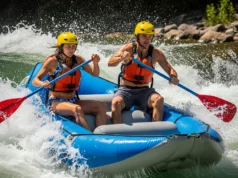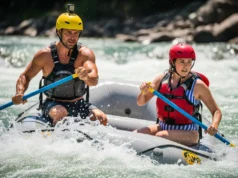In this article
The river drops away and all you hear is a deep, gut-rumbling roar. Ahead, a churning wall of white water—a hydraulic hole, a stopper—seems to stop the river in its tracks, daring you to enter. For many rafters, this is a moment of fear; for the prepared, it’s a challenge to be met with precision. This is where the river asks you a question, and your answer is delivered not with words, but with an aggressive attitude and decisive action. This guide is your definitive blueprint for turning that intimidation into domination, deconstructing the physics of a hydraulic and arming you with the trinity of Speed, Angle, and Power needed for a successful downstream punch.
Mastering a hydraulic hole is not about brute force. It’s about transforming a scientific understanding of the river into confident action as you progress into Class III and Class IV rapids. It’s about converting primal fear into sharpened wilderness instinct. Together, we will deconstruct this demon, learning its anatomy from the wave wall to the boil line so you understand exactly what you’re up against. We will master the Rafter’s Trinity—the coordinated application of Speed, Angle, and Power that is the non-negotiable formula for a successful punch. You will develop a strategic eye, using a clear framework to make smart, on-the-fly decisions about when to punch and, more importantly, when to find another way. And finally, we will plan for failure so that you can act with confidence, mastering the contingency plans that turn a potential crisis into a controlled recovery. You begin this journey intimidated by the raw power of a big, meaty hydraulic; you will finish with a clear, analytical framework and a tactical playbook, empowered to read, assess, and navigate these features with skill and superior judgment.
What is a River Hole? Deconstructing the Hydraulic
To conquer a powerful feature, you must first understand it. A hydraulic hole, often called a stopper by boaters, for all its chaos, is not a random monster. It is a predictable, analyzable water formation governed by the laws of fluvial morphology. Learning to see its structure is the first step in replacing fear with a calm, analytical mindset.
What is the anatomy of a hydraulic hole?
At its core, a hole is a hydraulic jump, a phenomenon that occurs when fast water flows over a submerged obstacle on the riverbottom—like a ledge or a large rock—and plunges into a deeper, slower pool downstream. This plunge creates a void, and the downstream water rushes back upstream to fill it. This powerful surface current, flowing back toward the obstacle, is known as recirculation or backwash. This is the primary upstream force your raft must overcome. A hole works on a continuum between a breaking wave and an eddy; add enough water to a hole, and it washes out to a wave.
An experienced boater doesn’t see a single churning mass; they see distinct, interconnected parts that tell a story about the hole’s power and personality.
The most visible feature is the Wave/Wall, the standing surface wave that forms where the water drops. Its height, steepness, and the whiteness of its foam are the first clues to its power. Immediately downstream of the wave is the Trough, a depression where the recirculating current is strongest. The specific upstream-moving current in the trough is called the Tow Back. The size and speed of the tow back act like a tractor beam, determining a hole’s “stickiness” or retentive power—its ability to stop and hold a raft.
Farther downstream is the Boil Line, a turbulent, aerated line where the recirculating water crashes into the main downstream current. A raft is not truly free of the hole’s grasp until it has completely crossed this line. Beyond it lies the Outflow, or “downstream green water.” This stable, flushing water is your goal, the safe harbor at the end of the maneuver. Learning to identify these parts from upstream is the foundational skill of reading a river, allowing you to predict a hole’s behavior before you ever enter it. And once you can read the water, you’ll need the skills to act on that knowledge, starting with the foundational rafting paddle strokes—like the draw and pry—that give you control.
How Do You Strategize for a Hydraulic Hole?
Technical skill gets you through a rapid. Strategic thinking gets you through safely. This is the cognitive layer of whitewater boating—the scouting process, risk assessment, and pre-rapid decision-making. It’s about moving from simply reacting to the river to proactively choosing your safe line through a rapid after an eddy turn or peel out.
How do you read a hole to find its weak spot?
In a natural river, holes are rarely uniform. Your primary goal during scouting is to aim for the weak spot—a path of least resistance where the downstream current is more dominant than the recirculation. This is your target. Look for a Visible Outflow, which often appears as a tongue of “green water” cutting through the whitewater. This indicates a weaker tow back and a clearer exit. Also, pay close attention to Boil Line Proximity. The weak spot is often where the turbulent boil line is closest to the wave face, indicating a smaller, less powerful recirculation zone. Scouting should be done from upstream, but a shore scout provides a much better perspective on the hole’s overall structure and any hidden downstream hazards.
The hole shape, whether it’s a pourover hole or a ledge hole, is a critical clue. A “smiling” hole, with its ends curved downstream, naturally funnels water and objects out toward the sides, making its weak points obvious. Conversely, a “frowning” hole or horseshoe hole, with its hole curve upstream, funnels energy toward its powerful center, making escape much more difficult. The most critical classification is the “Keeper” or “Terminal” Hydraulic, like the infamous ones at Woodall Shoals on the Chattooga River. Often formed by uniform, man-made structures like low-head dams, these bad holes have no discernible weak spots and must be avoided at all costs. The ability to consistently identify these features from a distance is a hallmark of a superior boater, a skill validated by detailed river studies like the one conducted for the Chattooga Wild and Scenic River study. Identifying this weak spot is useless, however, without the technical skill to position your raft, which is where learning the pro-level secrets of raft ferrying becomes crucial.
How do you decide whether to punch or avoid a hole?
Expert decision-making can be formalized using a Hole Danger Assessment Matrix. This tool provides risk-evaluated guidance, moving beyond a simple “good” or “bad” label to weigh a hole’s inherent power against the consequences of a failed attempt. It acts as a progressive difficulty rating system for on-the-fly choices.
The first variable is Retentiveness (the “Stickiness” Factor). This measures the hole’s ability to hold a raft. It ranges from Low (a flushing wave) to Medium (a surfable hole) and High (a uniform, frowning shape with a powerful tow back). Extreme Retentiveness defines a “keeper” hole, a “no-go” situation.
The second variable is Consequence (the “What If” Factor). This assesses the risk level of the environment downstream of the hole. Low Consequence is a deep, calm, hazard-free pool. High Consequence could be another significant rapid, a rock garden, or known hazards like undercuts immediately below. Extreme Consequence is an un-runnable hazard like a waterfall, making any mistake unacceptable.
Pro-Tip: Before dropping into any significant rapid, your guide should have a clear “Plan B” and “Plan C.” Ask about them. Knowing the contingency plan for a failed line not only prepares you for what to do but also gives you immense confidence in your guide’s judgment and foresight.
By plotting a hole on this matrix, you get a clear strategic imperative: Punch, Play, or Portage. This systematic approach to risk management is the core principle of the American Whitewater Safety Code, which emphasizes pre-run assessment for all whitewater boaters.
What is the Technique for Punching a Hole?
With your strategic decision made, the moment arrives to commit. Success now depends on flawless technical execution. This is a coordinated, violent, and beautiful maneuver that relies on the crew and guide acting as one.
What are the three core principles of a successful punch?
Principle 1: Speed is Your Shield. Momentum (mass x velocity) is the single most important factor. You must approach the hole with speed to generate enough downstream momentum to overcome the hole’s tow back. This is built by positioning the raft in the fastest current and having the crew paddle hard in unison. The boat power of a heavy, gear-laden R6 raft provides more momentum but is slower to accelerate, whereas a lighter R2 requires more velocity.
Principle 2: Angle of Attack. The ideal angle of approach is perfectly perpendicular (90 degrees) to the hole’s primary wave face. Hitting a hole laterally, or from the side, exposes the long side of the raft to the current, creating a high probability of the upstream tube being pulled down, leading to a flip or “dumptruck.”
Principle 3: Power on Impact. This isn’t just continuous paddling; it’s a final, coordinated, explosive burst of crew power. The stroke timing is crucial: take your last stroke just as you impact the wave wall. Good paddlers must dig their blades deep—stroke depth is everything—to find the solid “green water” beneath the aerated foam and use that last stroke to pull yourself through. The science of why momentum is so critical is explained in depth by fluid dynamics experts who study open-channel hydraulics for paddlers, providing a basis for this technique.
Underpinning all three principles is the Aggressive Forward Lean. Every crew member shifts their weight forward, helping the bow pierce through the wave. Failing to do this can lead to the stern catching, causing a “stern squirt” that can wash paddlers out of the boat. This single action is the linchpin of a successful punch. Delivering that power on impact requires strength, and developing it is a craft in itself. Consider running a personal Paddling Strength Audit to find and fix your weak links.
What Do You Do When a Punch Fails?
True confidence on the river is born not from a perfect record, but from knowing exactly what to do when things go wrong. A rafter is defined not just by their success, but by their calm and effective response to adversity, a core skill in swiftwater rescue.
What is the immediate action if you get stuck side-surfing?
If a raft loses momentum and you’re getting stuck, it can be held in place by the tow back and get turned sideways—a position called a “side surf.” This is dangerous. The powerful upstream current will try to climb over the upstream tube and flip the raft, a situation known as “window shading.”
The immediate, most critical, and non-negotiable action is the “High Side!” command from the guide. Upon this command, all crew members must instantly move their weight to the downstream tube (the “high side”), leaning hard and even climbing over if necessary. This aggressive weight shift changes the raft’s center of gravity, keeping the boat tilted downstream, lifting the vulnerable upstream edge out of the water and allowing the current to flow underneath instead of over it. A strong brace on the downstream side can add stability.
Pro-Tip: Practice the “High Side” command in a safe, calm eddy. Have the guide call it out unexpectedly. The goal is to make the crew’s reaction instantaneous and instinctual, without a moment’s hesitation. Muscle memory built in calm water is what saves you in chaos.
While maintaining the high side, the crew must work to maneuver the raft toward a weak spot. If the raft is stalled but still facing mostly downstream, a series of powerful back strokes can sometimes generate enough reverse momentum to pull it free. Knowing how to react to these hazards is a core tenet of boating education, as emphasized by platforms like Boat-Ed in their guide to understanding river characteristics for boaters. In any rescue scenario, your primary tool will be the throw rope; our expert guide to river rescue throw bags covers how to choose and use one effectively for rescuing swimmers.
What should you do in a flip or swim scenario?
If your raft flips in a hole, your first priorities are to find air and locate the raft. It is critical to get to the upstream side of the flipped boat to avoid being crushed between it and a downstream obstacle. Once the crew is accounted for, the raft can be righted using “flip lines” and crew members can begin the re-entry process.
If you are swimming freely in a rapid, immediately assume the Defensive Swimmer’s Position or float position: lying on your back, feet up and pointed downstream, with your head above water. This lets your feet and legs absorb impacts and allows you to see where you’re going. Crucially, never attempt to stand up in fast-moving water deeper than your knees. If your foot becomes entrapped, the force of the current can instantly push you underwater, a leading cause of flush drownings. When you identify a clear path to safety, transition to swimming aggressively by rolling onto your stomach and using a powerful freestyle or crawl stroke. These self-rescue techniques are essential river running skills taught in every reputable whitewater course. The life-or-death scenario of a swim is a stark reminder that your PFD and helmet are the most important pieces of gear you own; make sure yours matches your exact river style with the perfect rafting PFD.
Conclusion
You stand at the edge of the rapid, armed with new knowledge. The roar is the same, but you hear it differently now. A hydraulic hole is a predictable feature governed by physics, its power revealed by its anatomy. Punching it is a technical act, a coordinated application of the Rafter’s Trinity—Speed, Angle, and Power. But true mastery lies in judgment: in scouting for the weak spot, in using a risk assessment framework to make a sound call, and in knowing the immediate, life-saving responses to failure like the “High Side” command and the “Defensive Swimmer’s Position.”
You now have the blueprint. The next step is to practice these skills on smaller, safer rapids. Explore our full library of rafting technique guides to continue building your wilderness instinct. The river is waiting.
Frequently Asked Questions about Punching Rafting Holes
What’s the single most important factor for a raft to successfully punch a hole?
Momentum is the single most important factor. Your raft must carry enough downstream speed to overcome the hole’s powerful upstream-flowing current (the tow back).
What does it mean to “high side” a raft when you’re stuck in a hole?
“High-siding” is the critical command for all crew members to immediately move their weight to the downstream tube of the raft. This action lifts the upstream tube out of the water, preventing the current from flipping the boat.
What is the difference between a “smiling” and a “frowning” hole?
A “smiling” hole has ends that point downstream, which naturally funnels water and objects out to the sides, providing easier escape routes. A “frowning” hole has ends that point upstream, which dangerously funnels everything toward the powerful center, making it much more difficult to escape.
Should you ever try to stand up while swimming in a rapid?
No, you should never attempt to stand up in fast-moving water deeper than your knees. This prevents the life-threatening risk of foot entrapment, where your foot gets caught on the river bottom and the current forces your body and head underwater.
Risk Disclaimer: Whitewater rafting, kayaking, and all related river sports are inherently dangerous activities that can result in serious injury, drowning, or death. The information provided on Rafting Escapes is for educational and informational purposes only. While we strive for accuracy, the information, techniques, and safety advice presented on this website are not a substitute for professional guide services, hands-on swiftwater rescue training, or your own critical judgment. River conditions, including water levels, currents, and hazards like strainers or undercut rocks, change constantly and can differ dramatically from what is described on this site. Never attempt to navigate a river beyond your certified skill level and always wear appropriate safety gear, including a personal flotation device (PFD) and helmet. We strongly advise rafting with a licensed professional guide. By using this website, you agree that you are solely responsible for your own safety. Any reliance you place on our content is strictly at your own risk, and you assume all liability for your actions and decisions on the water. Rafting Escapes and its authors will not be held liable for any injury, damage, or loss sustained in connection with the use of the information herein.
Affiliate Disclosure: We are a participant in the Amazon Services LLC Associates Program, an affiliate advertising program designed to provide a means for us to earn advertising fees by advertising and linking to Amazon.com. As an Amazon Associate, we earn from qualifying purchases. We also participate in other affiliate programs and may receive a commission on products purchased through our links, at no extra cost to you. Additional terms are found in the terms of service.





